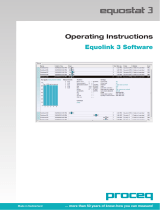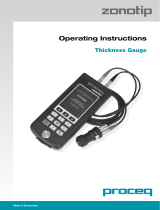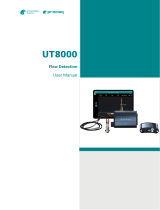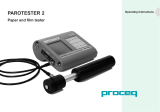Page is loading ...

SCHMIDT OS-120
OPERATING INSTRUCTIONS
Swiss Solutions since 1954

© 2017 Proceq SA 1
Contents
1. Safety and Liability ......................................2
1.1 Safety and Usage Precautions ...............................2
1.2 Liability..................................................2
1.3 Safety Instructions.........................................2
1.4 Designated Use ...........................................2
2. Instrument Selection.....................................3
2.1 Schmidt OS-120 Models ....................................3
3. Schmidt OS-120 Layout ..................................3
4. Measuring and Evaluation with the Schmidt OS-120PT .........4
4.1 Functional Check..........................................4
4.2 Preparations..............................................5
4.3 Measuring ...............................................6
4.4 Conversion Curves for Schmidt OS-120PT......................6
5. Measuring and Evaluation with the Schmidt OS-120PM.........9
5.1 Functional Check..........................................9
5.2 Preparations..............................................9
5.3 Measuring ...............................................9
5.4 Rating Table for Schmidt OS-120PM .........................10
6. Technical data .........................................10
7. Standards and Guidelines................................11
7.1 Standards ..............................................11
7.2 Guidelines ..............................................11
8. Part Numbers and Accessories ...........................11
8.1 Units...................................................11
8.2 Accessories .............................................12
9. Maintenance and Support................................12
9.1 Maintenance ............................................12
9.2 Support Concept .........................................12
9.3 Standard Warranty and Extended Warranty ....................12

© 2017 Proceq SA 3
2 © 2017 Proceq SA
2. Instrument Selection
2.1 Schmidt OS-120 Models
There are two models available.
• OS-120PT for testing concrete in the very low compressive strength range. Typically from 1 N/
mm2 to 5.0 N/mm2 ( 145 psi – 725 psi). This makes the instrument very suitable for testing fresh
concrete to determine the time for formwork removal.
• OS-120PM for testing the mortar joints in brick constructions.
3. Schmidt OS-120 Layout
1 Housing with handle
2 Reset lever
3 Hammer complete (PM/PT)
4 Trigger button
5 Scale (Rebound value)
6 Control knob
7 Hammer head (PM/PT)
A Contact surface
B Loading position
Hammer head Schmidt OS-120PT (7) Hammer head Schmidt OS-120PM (7)
1. Safety and Liability
1.1 Safety and Usage Precautions
This manual contains important information on the safety, use and maintenance of the OS-120PT/
PM. Read through the manual carefully before the first use of the instrument. Keep the manual in a
safe place for future reference.
1.2 Liability
Our “General Terms and Conditions of Sale and Delivery” apply in all cases. Warranty and liability
claims arising from personal injury and damage to property cannot be upheld if they are due to one
or more of the following causes:
• Failure to use the instrument in accordance with its designated use as described in this manual.
• Incorrect performance check for operation and maintenance of the instrument and its compo-
nents.
• Failure to adhere to the sections of the manual dealing with the performance check, operation
and maintenance of the instrument and its components.
• Unauthorized structural modifications to the instrument and its components.
• Serious damage resulting from the effects of foreign bodies, accidents, vandalism and force
majeure.
All information contained in this documentation is presented in good faith and believed to be
correct. Proceq SA makes no warranties and excludes all liability as to the completeness and/or
accuracy of the information.
1.3 Safety Instructions
The instrument is not allowed to be operated by children or anyone under the influence of alcohol,
drugs or pharmaceutical preparations. Anyone who is not familiar with this manual must be super-
vised when using the instrument.
1.4 Designated Use
• The instrument is only for its designated purpose as described in these operating instructions.
• Replace faulty components only with original replacement parts from Proceq.
• Accessories should only be installed or connected to the instrument if they are expressly autho-
rized by Proceq. If other accessories are installed or connected to the instrument then Proceq will
accept no liability and the product guarantee is forfeit.

© 2017 Proceq SA 5
4 © 2017 Proceq SA
4. Measuring and Evaluation with the Schmidt OS-120PT
The OS-120PT is primarily used to measure the early compressive strength of concrete non-
destructively. Measurements can also be made on lightweight concrete, plasterboard and similar
products.
NOTE! At all times ensure that all your body parts are kept away from the space between
the hammer head (7) and the contact surface A.
4.1 Functional Check
A test anvil is necessary for the functional check of the rebound hammer (see chapter 8.2).
Checking the Schmidt OS-120PT on the test anvil
The functional check should ideally be performed before and after each usage of the hammer. As a
minimum it should be carried out after 1’000 impacts or once every three months.
• Insure that the control knob (6) is set at the position H. If not proceed with steps 1 to 6 as de-
scribed in Chapter 4.2.
• Place the test anvil on a hard, smooth surface (e.g. stone floor).
• Clean the contact surfaces of the anvil and the hammer head.
• Carry out a few impacts on the anvil.
• Perform 10 test impacts on the test anvil.
NOTE! The mean of the rebound values must lie within the tolerance given on the anvil.
If this is not the case, e.g following an impact, the hammer mass is not held at the maxi-
mum rebound position, then the brake strip must be cleaned.
• Clean the brake strip on the under side of the semi-circular housing (1) using a clean cloth soaked
in Acetone. When cleaning with Acetone the paint close to the brake surface may be affected.
Alternatively, methylated spirit that does not damage the paint can be used.
• Repeat the functional check.
If the mean value is still out of tolerance, the instrument must be taken to an authorized service
centre for re-calibration.
4.2 Preparations
If necessary, use the grinding stone to remove cement residues from the test surface.
Hammer (3) at
position 75
• The control knob (6) must be at the desired position V (for testing on vertical surfaces) or H (for
testing on horizontal surfaces).
If this is not the case proceed as follows:
1. Place the OS-120 on a flat surface with the scale up and the hammer (3) at loading position B
as shown in the first picture of chapter 3.
2. Release the hammer (3) by pushing the reset lever (2) in a downwards direction, keep holding.
3. Press, hold down and release the trigger button (4) to move the entire hammer (3) to the posi-
tion 75 on the scale (5).
4. Push reset lever (2) down to hold the hammer (3) in place.
5. Turn the control knob (6) to position V for testing on a vertical surface, respectively to H for
testing on a horizontal surface.
6. Push hammer (3) back to position B. It will click into loading position.
NOTE! The hammer (3) MUST be set to position 75 to enable you to select V or H with
the control knob (6).
(typically)
Accuracy of rebound values: For OS-120 PT 176 ± 3
For OS-120 PM 186 ± 3

© 2017 Proceq SA 7
6 © 2017 Proceq SA
4.3 Measuring
1. Place the OS-120 on a flat surface. Check that hammer (3) is at loading position B.
2. Push the reset lever (2) in a downward direction at loading position B.
3. Go to the test location.
4. Grip the OS-120PT by the handle on the housing (1). Exert a light pressure against the test
surface towards the side where the contact surfaces (A) of the housing (1) are located. This
ensures that the contact surfaces (A) lie flush against the surface (see the pictures below).
B
A
A
B
5. Trigger the impact by pressing the trigger button (4).
6. Read the rebound value from the scale (5).
7. Push the hammer (3) back to position B to perform the next impact.
Repeat the procedure as many times as the standard you are working to requires. For example, EN
12504-2 requires a minimum of 9 rebound values for calculating the median.
The rebound value determined in this way can be converted to a compressive strength estimate
using the conversion curves (See chapter 4.4.) However, we recommend the creation of a user
defined curve specifically for the concrete under test. An EXCEL Macro is available with the product
documentation and also on the Proceq website to assist with this.
When the measurement is completed:
• Check the Schmidt OS-120PT on the anvil. (see chapter 4.1).
• Put the Schmidt OS-120PT into the neutral position. i.e. set the Schmidt OS-120PT on a horizon-
tal surface (e.g. leave it on the anvil after the control check), set the control knob (6) to position V,
depress the reset lever (2) to bring the hammer to position (B) and lock it in place by pushing the
lever (2) upwards. The OS-120PT may now be stored in the case.
4.4 Conversion Curves for Schmidt OS-120PT
The typical measuring range, respectively the compressive strength range of the concrete under
test lies between 1 N/mm2 (145 psi) and 5 N/mm2 (725 psi). Typical curves are presented for this
range on the following two pages.
For the creation of own conversion curves please refer to the “SilverSchmidt Original Schmidt_
Function_to_estimate_Compressive_Strenght_of_Concrete_v1.04_E.xls” in the download area of
the Proceq website and on the DVD provided with the instrument.
0.00
1.00
2.00
3.00
4.00
5.00
6.00
0 5 10 15 20 25 30 35 40 45 50
OS-120 PT Conversion Curve Cube 150/150/150
Horizontal impct direction N/mm2 y = 1.05 * (0.0009x2 + 0.0808x - 0.5081)
Vertical impact direction N/mm2 y = 1.05 * (0.0015x2 + 0.0615x - 0.3585)
fc Cube 150/150/150
fc [N/mm2 ]
R
0.00
0.50
1.00
1.50
2.00
2.50
3.00
3.50
4.00
4.50
0 5 10 15 20 25 30 35 40 45 50
OS-120 PT Conversion Curve Cylinder 150/300
Horizontal impact direction N/mm2 y = 0.8337 * (0.0009x2 + 0.0808x - 0.5081)
Vertical impact direction N/mm2 y = 0.8337 * (0.0015x2 + 0.0615x - 0.3585)
fc Cylinder 150/300
fc [N/mm2 ]
R

© 2017 Proceq SA 9
8 © 2017 Proceq SA
0
100
200
300
400
500
600
700
800
900
0 5 10 15 20 25 30 35 40 45 50
OS-120 PT Conversion Curve Cube 150/150/150
Horizontal impact direction psi y = 152.2899 * (0.0009x2 + 0.0808x - 0.5081)
Vertical impact direction psi y = 152.2899 * (0.0015x2 + 0.0615x - 0.3585)
fc Cube 150/150/150
fc [psi]
R
0
100
200
300
400
500
600
700
0 5 10 15 20 25 30 35 40 45 50
OS-120 PT Conversion Curve Cylinder 150/300
Horizontal impact direction psi y = 120.918 * (0.0009x2 + 0.0808x - 0.5081)
Vertical impact direction psi y = 120.918 * (0.0015x2 + 0.0615x - 0.3585)
fc Cylinder 150/300
fc [psi]
R
A form factor must be used to correct the conversion estimate in cases where the compressive
strength is not to be used as either as standard cube compressive strength (150/150/150 cube) or
a standard cylinder compressive strength (150/300 cylinder). (See the corresponding information in
the document delivered with the instrument, or on the Proceq website.)
5. Measuring and Evaluation with the Schmidt OS-120PM
The OS-120PM is used to test the mortar of joints in masonry constructions non-destructively. The
mortar can then be classified based on the rebound value. The classification is only valid for mea-
surements on vertical walls.
For a detailed description of the procedures of the following three chapters 5.1, 5.2 and 5.3 refer to
the chapters 4.1, 4.2 and 4.3.
NOTE! At all times ensure that all your body parts are kept away from the space between
the hammer head (7) and the contact surface A.
5.1 Functional Check
The functional check of the Schmidt OS-120PM is carried out in the same way as for the Schmidt
OS-102PT (see chapter 4.1).
5.2 Preparations
• Identify a suitable location on the mortar joint. If necessary, remove any dirt or moss, etc.
• The hammer (3) must be fixed at position 75 on the scale (5) and the control knob (6) turned to
position V (for testing on vertical surfaces). See respective picture in chapter 4.2.
5.3 Measuring
• Grip the Schmidt OS-120PM by the handle on the housing (1). Exert a light pressure against the
test surface towards the side where the contact surfaces (A) of the housing (1) are located. This
ensures that the contact surfaces (A) lie flush against the surface. Additionally make certain that
the joint to be tested is precisely in the middle of the circular opening of the housing (1) in position
A. This will ensure that the hammer head (7) impacts on the surface of the joint. (See the picture
below.)
• Using the reset lever (2), bring the hammer (3) to position B.
A
B

© 2017 Proceq SA 11
10 © 2017 Proceq SA
• Trigger the impact by pressing the trigger button (4).
• Read the rebound value from the scale (5).
Repeat the procedure as many times as the standard you are working to requires. For example, EN
12504-2 requires a minimum of 9 rebound values for calculating the median.
The rebound value determined in this way can be used to give a classification by means of the
evaluation table. (See chapter 5.4).
When the measurement is completed:
• Check the Schmidt OS-120PM on the anvil (see chapter 4.1)
• Put the Schmidt OS-120PM into the neutral position. i.e. set the OS-120PM on a horizontal
surface (e.g. leave it on the anvil after the control check), set the control knob (6) to position V,
depress the reset lever (2) to bring the hammer (3) to position (B) and lock it in place by pushing
the lever (2) upwards. The Schmidt OS-120PM may now be stored in the case.
5.4 Rating Table for Schmidt OS-120PM
The mortar joints can be classified using the rating table below.
Classification
Excellent
Very good
Good
Reasonable
Average
Poor
10 20 30 40 50 60 70 80 90 100
Rebound value R
The customer is free to create his own mortar specific rating table.
6. Technical data
Schmidt OS-120PT Schmidt OS-120PM
Measuring range See chapter 4.4 See chapter 5.4
Impact energy 0.833 Nm (0.614 ft lbf)
Accuracy (of rebound value on anvil) typically 176 ± 3 typically 186 ± 3
Hammer mass 720 g (1.59 lb) 665 g (1.47 lb)
Hammer head diameter 40 mm (1.57“) 8.0 mm (0.315“)
Weight 3.45 kg (7.60 lb)
Dimensions of housing 230 x 60 x 200 mm (9.06“ x 2.36“ x 7.87“)
Schmidt OS-120PT Schmidt OS-120PM
Operating temperature -10 bis 50°C (14 bis 122°F)
Storage temperature -10 bis 70°C (14 bis 158°F)
7. Standards and Guidelines
7.1 Standards
The rebound number is determined on the basis of the following standards: EN12504-2 (Europe),
ASTM C 805 (North America), JGJ/T 23-2011 (China). Applies to Schmidt OS-120PT only.
For the creation of user defined conversion curves, we recommend the procedures described in EN
13791 (Europe), ASTM C805, ACI 228.1R (North America), JGJ T23-2011 (China), see chapter 4.4.
Applies to Schmidt OS-120PT only.
7.2 Guidelines
Austrian Guideline for tunnel lining, published December 2012. Austrian Construction Association.
(To determine the time for formwork removal during tunnel construction). Applies to Schmidt OS-
120PT.
TNO Report BI -88-009/61.8.2060-VOE from IBBC Delft Netherlands (Mortar joint testing). Applies
to Schmidt OS-120PM.
8. Part Numbers and Accessories
8.1 Units
PART NUMBER DESCRIPTION
310 06 001 OS-120PT Concrete test hammer including,
operating instructions, certificate of conformity,
CD with documentation, grinding stone and car-
rying case
310 06 002 OS-120PM Mortar test hammer including opera-
ting instructions, certificate of conformity, CD with
documentation and carrying case

© 2017 Proceq SA 13
12 © 2017 Proceq SA
Notes8.2 Accessories
PART NUMBER DESCRIPTION
310 99 037 Grinding stone (only required for OS-120-PT)
310 06 058 Carrying case
310 10 000 Test anvil
9. Maintenance and Support
9.1 Maintenance
Maintenance includes a regular check of the instrument and cleaning of the breaking strip as de-
scribed in chapter 4.1.
To guarantee consistent, reliable and accurate measurements, the instrument should be calibrated
on a yearly basis. The customer may however, determine the service interval based on his own
experience and usage.
Normal use may result in smaller damages to the paint, for example, inside of the housing (1) at the
loading position (B) caused by the hammer (3). This will neither impair the functioning nor the life
span of the Schmidt OS-120.
9.2 Support Concept
Proceq is committed to providing a complete support service for this instrument by means of
our global service and support facilities. It is recommended that the user register the product on
www.proceq.com to obtain the latest on available updates and other valuable information.
9.3 Standard Warranty and Extended Warranty
The standard warranty covers the mechanical portion of the instrument for 6 months.

14 © 2017 Proceq SA
Proceq Europe
Ringstrasse 2
CH-8603 Schwerzenbach
Switzerland
Phone +41 43 355 38 00
Fax +41 43 355 38 12
info-europe@proceq.com
Proceq UK Ltd.
Bedford i-lab, Priory Business Park
Stannard Way
Bedford MK44 3RZ
United Kingdom
Phone +44 123 483 45 15
Proceq USA, Inc.
117 Corporation Drive
Aliquippa, PA 15001
U.S.A.
Phone +1 724 512 03 30
Fax +1 724 512 03 31
Proceq Asia Pte Ltd
12 New Industrial Road
#02-02A Morningstar Centre
Singapore 536202
Phone +65 638 239 66
Fax +65 638 233 07
Proceq Rus LLC
Ul. Optikov 4
korp. 2, lit. A, Office 410
197374 St. Petersburg
Russia
Phone/Fax +7 812 448 35 00
Proceq Middle East
P. O. Box 8365, SAIF Zone,
Sharjah, United Arab Emirates
Phone +971 6 557 8505
Fax +971 6 557 8606
Proceq SAO Ltd.
Rua Paes Leme, 136, cj 610
Pinheiros, São Paulo
Brasil Cep. 05424-010
Phone +55 11 3083 38 89
Proceq China
Unit B, 19th Floor
Five Continent International Mansion, No. 807
Zhao Jia Bang Road
Shanghai 200032
China
Phone +86 21 631 774 79
Fax +86 21 631 750 15
Subject to change. Copyright © 2017 by Proceq SA, Schwerzenbach. All rights reserved.
Part Number: 82031002E ver 10 2017
/











